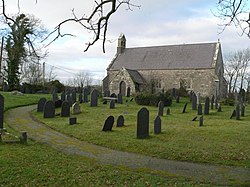| Heneglwys | |
|---|---|
 | |
Location within Anglesey | |
| Principal area | |
| Preserved county | |
| Country | Wales |
| Sovereign state | United Kingdom |
| Police | North Wales |
| Fire | North Wales |
| Ambulance | Welsh |
| UK Parliament | |
| Senedd Cymru – Welsh Parliament | |
Heneglwys (meaning 'Old Church') is a village in Anglesey, in north-west Wales. [1] St Llwydian's Church is of 12th century origin. [2] [3] It is in the community of Bodffordd, and until 1984 was its own community. [4]

